In this tutorial, we will learn How To Use Rank Math Analyzeron your site. SEO is the most consistent and long term traffic source that you can master. It can take some time to get started and optimize your website, but over time, it can snowball and bring you a lot of traffic. The best part is that you will need to invest less work into SEO over time, which dramatically improves your ROI.
SEO can be complicated and overwhelming, and that is one of the reasons many people shy away from it. There is on-page SEO, off-page SEO, and technical SEO. The names alone can be overwhelming.
But, once you start to understand the basics of SEO, the mystery unfolds quickly, and you can start to implement simple steps to improve your SEO.
We’re sure that you’ve heard about the 80-20 rule. The rule says that 80% of results come from 20% of the effort. This rule applies to SEO as well. If you invest 20% time in fixing the basic SEO mistakes, then you will already be on the path to get 80% results. To make the 20% easier for you, we built the SEO analysis tool right into Rank Math.
We’re going to introduce and talk about the SEO analysis tool in this article. It’s built inside Rank Math, and it analyzes your website for the basic SEO settings that you should absolutely get right. Remember the 80-20 rule? Getting the 20% wrong means that you will lose out on 80% of your results. That is why the SEO analyzer is so critical to use.
Let’s clear something up before we get into the post. Although the SEO analyzer will help you fix the most basic issues, you will still need to continuously perform SEO activities to get more traffic. There are millions of things that play a role in SEO, and it is not possible to configure them with an automated tool. That does not mean that the SEO analyzer is not important—it absolutely is! But, once you’ve used the SEO analyzer to improve your website, you will still need to keep improving if you expect to get more traffic from SEO.
Let’s get started with Rank Math‘s SEO analyzer.
Running the analysis is easy – just visit the “SEO Analysis” page under the SEO menu:
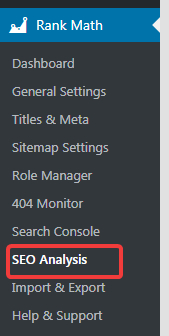
then click on the “Start Site-Wide Analysis” button at the top of the page:

Rank Math will start analyzing your site instantly. It only takes a few seconds – Rank Math will keep you updated during the process:

When it’s done, you’ll see a screen like this.
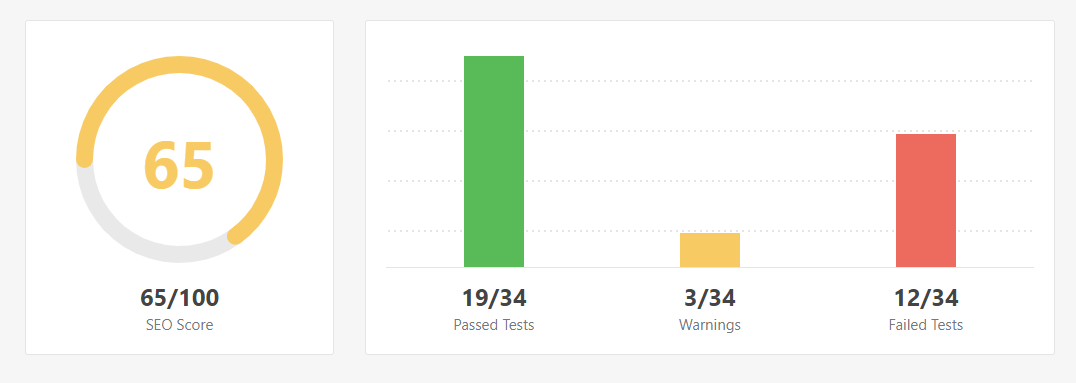
The charts at the top of the page are a quick summary of any found issues. The first point is the SEO score – this is a number from 0 to 100 – higher scores are better.
Next, there’s a bar chart showing the number of passed tests, warnings, and failed tests.
Tests that pass are great – they mean there’s nothing to fix.
Warnings are issues that are not very severe, but you should give them attention and do something about them.
The red bar represents failed tests. As you can see, there are plenty of failed tests in the image above, which means there is a lot of room for improvement.
When a test fails, it means there’s something seriously wrong that needs to be fixed immediately. These aren’t site breaking issues – your site still works. But they’re a disaster from an SEO perspective.
Moving down the screen, you can see more detailed feedback. Here, you can see what the tests are – what they’re measuring, and why your site passed or failed each one.
How To Use Rank Math Analyzer
Let’s break down each of the sections, and their individual tests to understand them in a deeper way:
Basic SEO
Basic SEO covers the bare essentials – if your site fails any of these tests, then there are serious issues that will hurt your rankings. You can think of the basic SEO settings as the foundation of your website. If the foundation itself is poorly built, then the building that stands on top of it will always be weak, or worse, collapse. If you want to build a healthy website for the long term, then you should absolutely have all the basic SEO settings optimized. Let’s take a look at each entry and explore what they mean and what you can do about them.
Common Keywords

The common keywords section displays a list of the most common keywords that Rank Math finds on your website. This is a handy feature, as these are the same words that search engines are also looking at when they crawl your website. Since search engines can’t read, the frequency of the terms used, and the terms themselves are the only factors that will help search engines determine what your website is about.
If you see unfamiliar terms here, then you should consider updating the content on your website. Rank Math will also try to determine the tropical relevancy of the terms it finds on your website and will show an indication about whether the intent of the website is clear or not.
As you can see in the image above, Rank Math is signaling that the terms most used on the website don’t have a clear intent by placing an exclamation mark in front of the terms.
How To Use Rank Math Analyzer
SEO Description

In this test, Rank Math checks your home page’s SEO description and tries to determine if it is search friendly. Rank Math will check for use of keywords, and if the description is too short or too long. If everything looks good, you’ll pass this test.
If you fail this test, try to customize the meta description of your website by adding a few important keywords and keeping the overall length between 50 to 160 characters.
H1 Heading

After the Title, the Headings are the next most important elements on the page, from which the H1 heading has the most precedence. In this test, Rank Math checks for the presence of an H1 heading on your page. If an H1 heading is present, you pass the test. Else, you do not.
If you fail this test, then head over to your page, and see if the title of the page is empty, as the page title is used as the H1.
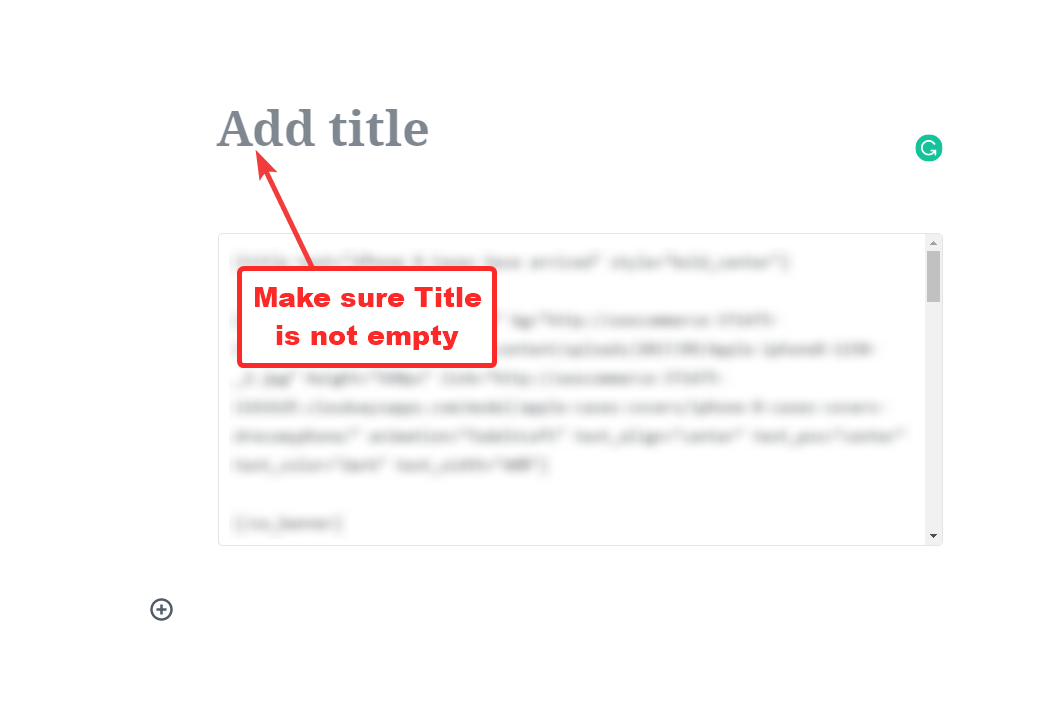
H2 Headings

After H1 headings, the H2 headings are the ones that have the most impact on the optimization of the page. In this test, Rank Math checks for the presence of an H2 heading on your page. If an H2 heading is found, you pass the test; else you do not.
If you fail this test, head over to your home page and add an H2 heading to it, choose a heading block, and confirm that it is configured to H2.

- How To Setup Rank Math Redirections In 4 Easy Steps
- How To Setup Rank Math SEO Plugin On Your Website [4 Easy Steps]
- Rank Math 404 Monitor, How To Fix 404 Errors In Rank Math Easily
- Rank Math FAQ [21 Solid Frequently Asked Questions And Answers By Rank Math]
Image ALT Attributes

Image ALT tags are a great way to markup your images so that the search engines can understand the context of the image better. They are also pretty useful for people when the images on a page fail to load, or for people using assisted devices to navigate the web. In this test, Rank Math checks if the images on your website have ALT tags specified. If all the images have ALT tags, you pass the test, else you fail.
If your website has a lot of images and you haven’t added ALT text to any one of them, you do not need to do the process manually. Rank Math features an automated solution for adding ALT text to images on the fly, meaning that your images will always be optimized. You can read about how to set it up here.
Keywords in Title and Description

The presence of important keywords in the Title and Description of your page is a strong ranking signal. In this test, Rank Math checks your page for the presence of useful keywords in the Title and the Description. If keywords are found, you pass the test.
If you fail the test, try to add some keywords related to your primary keywords in the title and description.
Link Ratio

Every page should have some links—that’s the foundation of the Internet. But how many links are OK? What should be the ration of internal and external links? To put these questions to rest, Rank Math tests how many links (internal and external) are present on your page and lets you know if the ration is healthy from an SEO perspective.
If you fail this test, then make sure that you are linking out to internal and external resources in a natural manner.
How To Use Rank Math Analyzer
SEO Title

The SEO title is important for 2 reasons. It lets search engines know what your website is about, and it also appears in the search results, where it can compel users to click through to your website. That is why your SEO title should be optimized for search engines and humans. In this test, Rank Math checks if your SEO title is of an appropriate length. If the title is too long, it will end up being truncated—which won’t be good. If the length of the title is appropriate, you will pass this test.
If you fail this test, head over to the page, and edit the SEO Title from Rank Math to make it the appropriate length.
Site Tagline

The site tagline is meant to describe what your site is about in a few words. WordPress uses it in a couple of places – usually in the header of each page, and in your RSS feeds. When you create a WordPress site, the tagline is set to “Just another WordPress site,” which is bad for several reasons.
First of all, it’s not very complimentary. It hardly looks professional, does it?
It’s a missed SEO opportunity, too. Using relevant text in the Site Tagline helps search engines to understand what your site is about. The text is included high on the page, and Google pays more attention to the text in critical positions.
What’s more, it makes your site a shining target for hackers – any hacker with a WordPress exploit can locate your site in seconds, and they usually attack hundreds of sites at a time.
Changing the tagline only takes a moment, so there’s no excuse for using the default value! The setting you’re looking for is in the Settings > General menu.

Blog Public

This optimization is critical to get right; else, your website may never appear in search engines.
When you install WordPress (or it is installed by your hosting provider), WordPress gives you an option to request search engines to not index your website. It is an optional setting, and it is off by default. The option itself is quite useful, as you can start building a website and not have a half-baked website appear in the search results.
But, many times, you start building your website with the option turned on, and then even when your website is built, you forget to turn it off. The result of that is, search engines come to index your website, but WordPress tells them that you don’t need your website indexed. Naturally, your website never makes it to their index, and as a result, you never get any traffic.
If you see a warning for this optimization (as you see in the screenshot above), then we highly recommend that you fix this as soon as possible. Head over to WordPress Settings -> Reading, and un-check this setting. You can also use the link provided in the error message to reach the setting quickly.

Don’t forget to save your settings once you un-check the checkbox. Once your settings are saved, your website should be indexed and should start appearing in the search results accordingly.
How To Use Rank Math Analyzer
Permalink Structure

Permalinks represent the structure of the URL for each post and page on your site. With a traditional blog, you can see the latest posts on the homepage. When you post new content, the old posts are pushed off the first page. If someone wanted to link to a post and they built a link to the homepage URL, people would see the wrong content when they click the link.
The solution is to create a unique link for each post – the permalink, because it’s permanent.
WordPress gives every post and page its own unique URL – which is great. But the standard format is pretty ugly. They usually look like this: http://www.mysite.com/?p=123
The number is the ID for the post – WordPress uses it to find the page content in the database. It’s ugly to look at, and there are some SEO drawbacks:
- There’s no keyword information – Google uses URLs as one of the ranking factors, so the URL should reflect what your post is about.
- People also read URLs, and that
?p=123doesn’t look appealing. Other bloggers are less likely to discover your work or link to it. - The question mark makes it obvious that the content is generated by a script (a program running on the server). Since the beginning, Google has preferred static content to script generated content.
Why doesn’t Google like content from scripts?
Often, scripts generate many pages of duplicate content. It’s hard to systematically crawl a scripted site because the server often generates new URLs with every page request – in other words, it looks like there’s an infinite number of pages. This situation is called a spider trap.
Sometimes, the content from scripts isn’t meant for the general public – for instance, private content for logged-in users. It’s never a good idea for spiders to attempt to access these URLs – most of the time, the server will block them. If the server has bad security, it will serve the pages and possibly leak private information.
For all these reasons, the Google bot is reluctant to crawl pages that contain a query (queries are the “?p=…” part of the URL). Of course, for SEO purposes, it’s important to make our site’s URLs as spider-friendly as possible.
Fortunately, it’s very easy to change the permalink structure on a WordPress site – the option is built right into the wp-admin panel. Just go to the Settings > Permalinks menu, and select the “Post Name” option.
Now all your permalinks will look like this: http://www.yoursite.com/your-post-name/ Not only is it more enticing to the spiders, but it also gives you an opportunity to get your keywords into the URL.
How To Use Rank Math Analyzer
Focus Keywords
When you write or edit an article, Rank Math helps you to choose a Focus Keyword and optimize your content for it. A web page can rank for many closely related keywords. But a well-written article should have a common theme – it should have focus. The focus keyword is the main focus of your article.
When you use a focus keyword, Rank Math can analyze your content and calculate how well optimized it is. If you don’t provide a focus keyword, Rank Math has no way of knowing how well optimized the article is.
In the SEO Analysis screen, Rank Math checks that you have a focus keyword set for every piece of content on your site. If it finds any content without keywords, it will alert you, and you can take action.
The process of adding the focus keywords is pretty easy, and Rank Math makes it even easier for you. In the error message itself, you should see links to posts, pages, and custom posts that do not have focus keywords set.

Clicking the link will take you to your posts screen, but only the posts that do not have focus keywords will be displayed. Here is how the screen would look if you’re wondering.

All you have to do is edit those posts, and add a suitable focus keyword to them.
Post Titles Missing Focus Keywords
In this test, Rank Math checks whether your focus keywords are present in your post’s title as well. Of course, this test only applies to the posts that have focus keywords set in the first place. If you have a lot of posts that do not have focus keywords set, then we’d recommending fixing those first and run the SEO Analyzer again to see all the posts that don’t have the focus keyword in the title.
The reason this test is in the Basic SEO section is that the title of the page is an important ranking signal for Google and other search engines. Think of it like this; if you’re looking for an iPhone charger, you’d expect the title of the page to be iPhone charger with some additional keywords like the brand, etc.
Similarly, if you’re trying to rank for a specific focus keyword and you don’t add that focus keyword to the title of the page, then you’re putting yourself at a big disadvantage.
To pass this test, edit the posts that do not have the focus keyword in the title (Rank Math will link directly to all the posts that do not pass this test), and add the focus keyword to the URL. Not only will you pass the test, but you will also increase your overall traffic.
How To Use Rank Math Analyzer
Advanced SEO
The Advanced SEO section is where Rank Math offers some advanced SEO tips that will help you take your website’s traffic to the next level. Here are the specific recommendations that you will see in this section.
Search Preview
Have you ever Googled your own website name just to see how the results look? If you have, you won’t have to do it anymore, as Rank Math does that for you. In this test, Rank Math gives you a preview of how your website appears in the search results on desktop. By looking at the preview, you can find out if your home page title, meta descriptions, and other things are on point. If they are not, you should make changes so that your website looks the best in the SERPS.

Mobile Search Preview
Mobile search has already overtaken desktop traffic and will continue to do so for the foreseeable future. It is vital that your website looks good in the mobile SERPs as well. In this test, Rank Math shows you a preview of your website on how it appears in the mobile search results. You can use this preview to fix problems (if any), improve your meta-title and description, make it the appropriate length, and more.

Mobile Snapshot
This is not actually a test, but more of a notification. Here, Rank Math takes a snapshot of your website from a mobile browser perspective and shows you the results on the screen. Using the screenshot, you can identify if your website is actually mobile-friendly. This test is quite important, as your website can be using a responsive theme and still not be mobile-friendly.
If you don’t like how your website looks on mobile, then consider changing your theme which is mobile friendly.
Canonical Tag
You might have noticed that a single post in WordPress can be accessed from multiple URLs. For example, a single post can have a URL of website.com/tag1/post/ or website.com/post or website.com/category/post, and so on. Since Google considers different URLs to be different pages, this can lead to Google indexing duplicate content on your website—unless you use canonical tags.
Canonical tags tell Google what the true URL of a page is. For example, for all the different URLs that we shared above, if a canonical tag was added to the posts if the URL website.com/post, then Google would know that that is the actual URL of the content, and it will safely ignore the rest.
In this test, Rank Math tests if your website has properly implemented canonical tags, and notifies you if it finds any errors. If you see errors here, then you’ll need to manually add some canonical URLs to fix them.
Head over to the page or post you’d like to work with, and open up the Advanced tab in Rank Math on the page. You’ll see the option of defining the canonical URL for the post there.
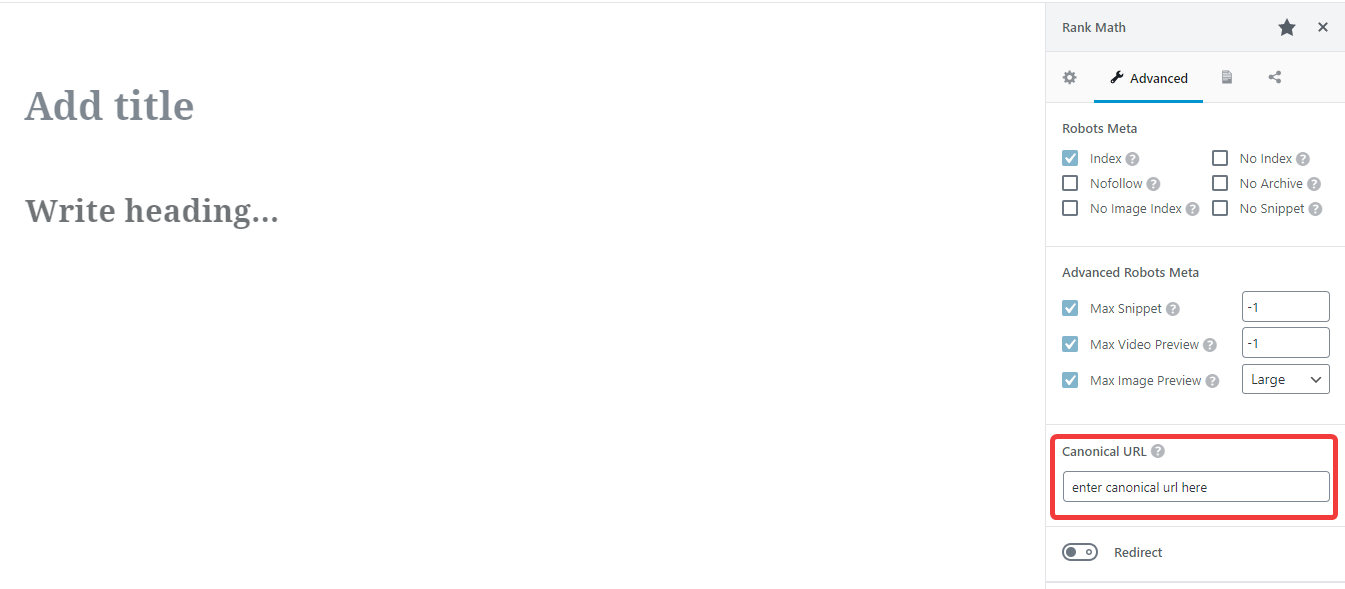
Noindex Meta
When you first install WordPress, you see an option to discourage search engines from indexing your website—which is on by default. If you’re just started to build your website, then it can be wise to turn it on. The problem happens when you forget to turn it off, and search engines send you no traffic—because you instructed them to.
In this test, Rank Math tests if your page contains a noindex meta or header, which will instruct the search engines to not index your website, and warns you if it does find it.
If you see an error here, make sure that the directive the error is based on is added on purpose. You should also check WordPress Settings > Reading to make sure that Search Engine Visibility checkbox is unchecked.

WWW Canonicalization
For Google, www.website.com and website.com mean different things, even if the difference is just www. When you set up your website for the first time, you have the option to choose between the www version or the non-www version. Whichever version you choose, the other version should be redirected to the original. For example, try opening-up www.wordpress.org, and you will end up on wordpress.org, as the www version is redirected to the non-www version.
In this test, Rank Math checks the same for your website. If the proper redirects are in place, you pass the test, else you fail.
If you fail this test, then you need to create 301 redirects from one version of your website to the other. The best method to do so is to create the proper rules in your .htaccess file. Here is an article on SiteGround showing how to redirect www URLs to the non-www version, and here is another one showing how to achieve the opposite.
OpenGraph Meta
Just as Schema helps search engines understand the content on websites, Facebook created Open Graph Protocol to transform web properties into rich objects. Similar to Schema, it is a markup that needs to be added to every page of your website, which Facebook and other social networks can read and understand your page, and also display it richly on their platforms.
In this test, Rank Math tests if the proper Open Graph tags have been added to your page. If all the appropriate tags are found, you pass the test.
If you fail this test, then you should head over to the post or page and open Rank Math’s social markup editor. Here is where it is located.
When you click the button, Rank Math’s social editor will open up, where you will be able to add the appropriate markup for the page/post.
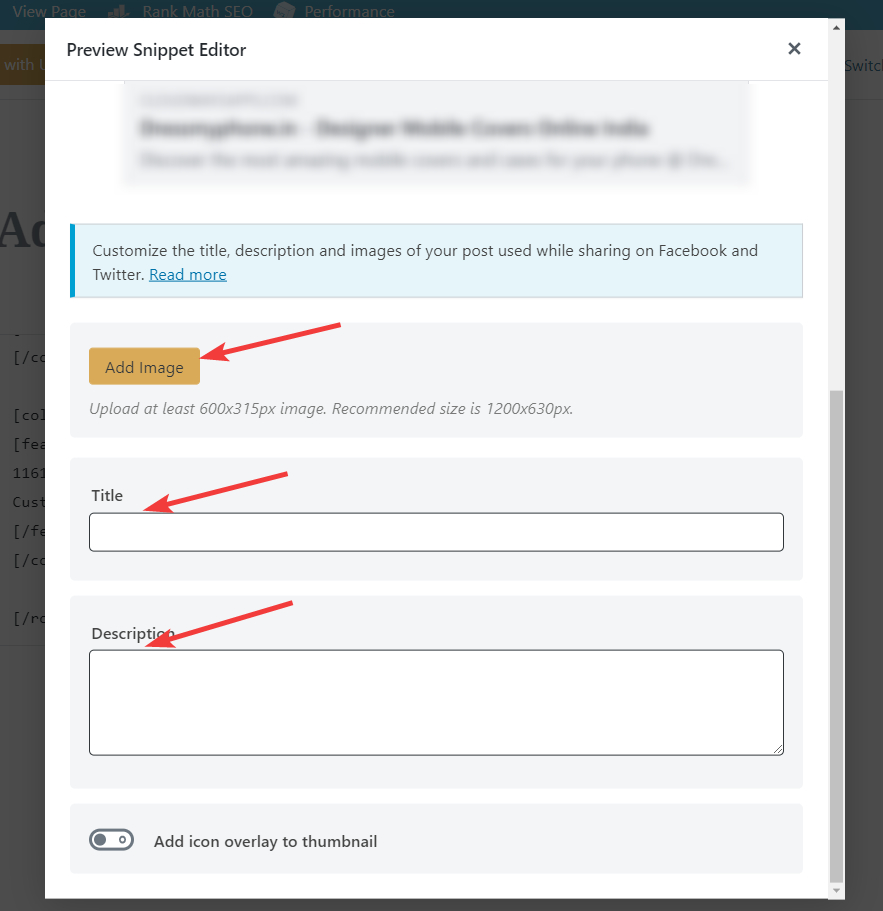
You can learn all about the social meta and its implementation on the dedicated article about Rank Math’s Social Meta Box.
To test your Open Graph implementation, you can also use Facebook’s Open Graph Object Debugger. Just enter the URL of the page you want to test, and click the Fetch new scrape information button, and Facebook will fetch the page and test the tags out.
Robots.txt

The robots.txt file is a special file present at the root of your web server, which directs search engines on what they should and should not index. It is an efficient way to manage search engines without having to use meta-robots on a lot of pages.
In this test, Rank Math looks for the presence of a robots.txt file, and you pass the test if it exists. Rank Math also tries to notify you if it finds a Disallow:tag in the file just as a warning.
It is unlikely that you will fail this test, as Rank Math usually places a simple robots.txt file on your server if it does not find one. However, if you still fail this test, you should contact your hosting provider to have it fixed and get the robots.txt file deleted so the one from Rank Math can work.
If you want to see or edit the contents of your robots.txt file, you can do so inside Rank Math. Just head over to General Settings > Edit robots.txt.
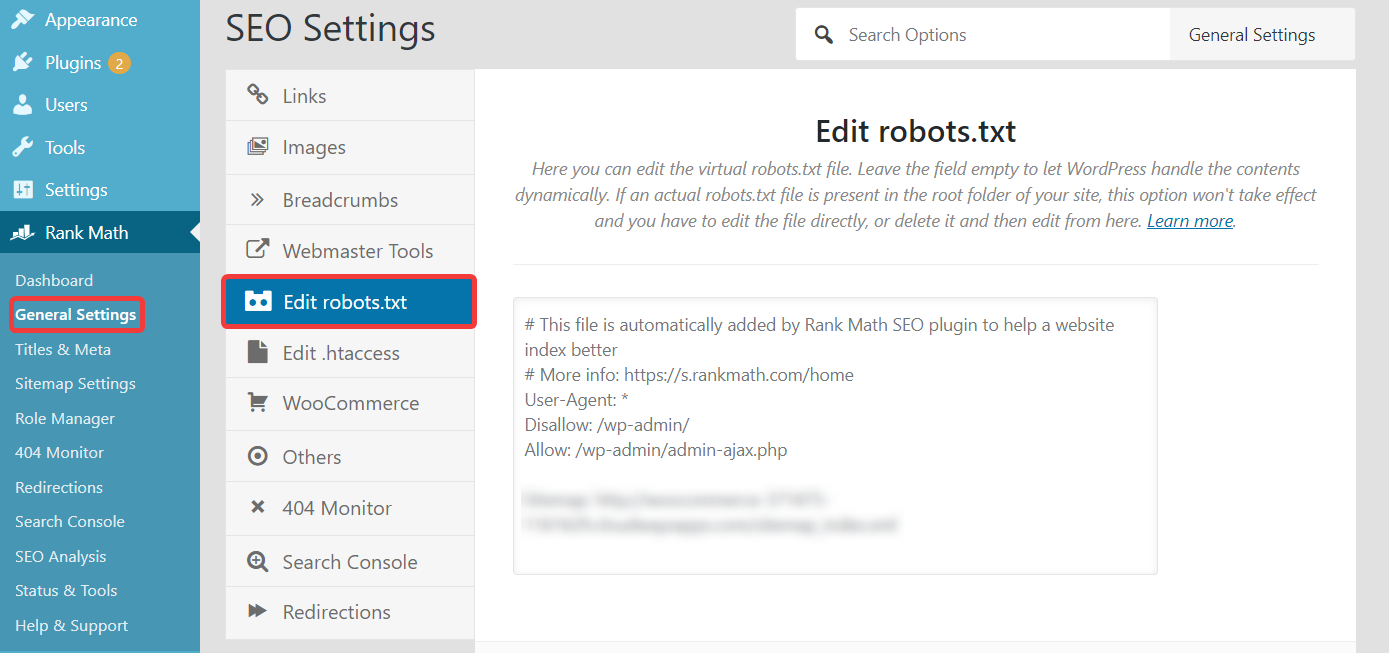
Schema Meta Data

Schema is the new language of the web. It is chunks of code that helps search engines understand the web and your website better. It is suspected that Schema will play an increasingly important role in the future, thus the need to have it implemented today.
In this test, Rank Math tests if your page consists of Schema Data, what type of Schema isn’t checked, and you pass the test if Schema data is found.
If you fail this test, then make sure to select a default Schema type for your posts inside Rank Math by heading to Rank Math > Titles and Meta > Posts > Schema Type. Once you do, Rank Math will automatically add the appropriate schema markup to all your posts.
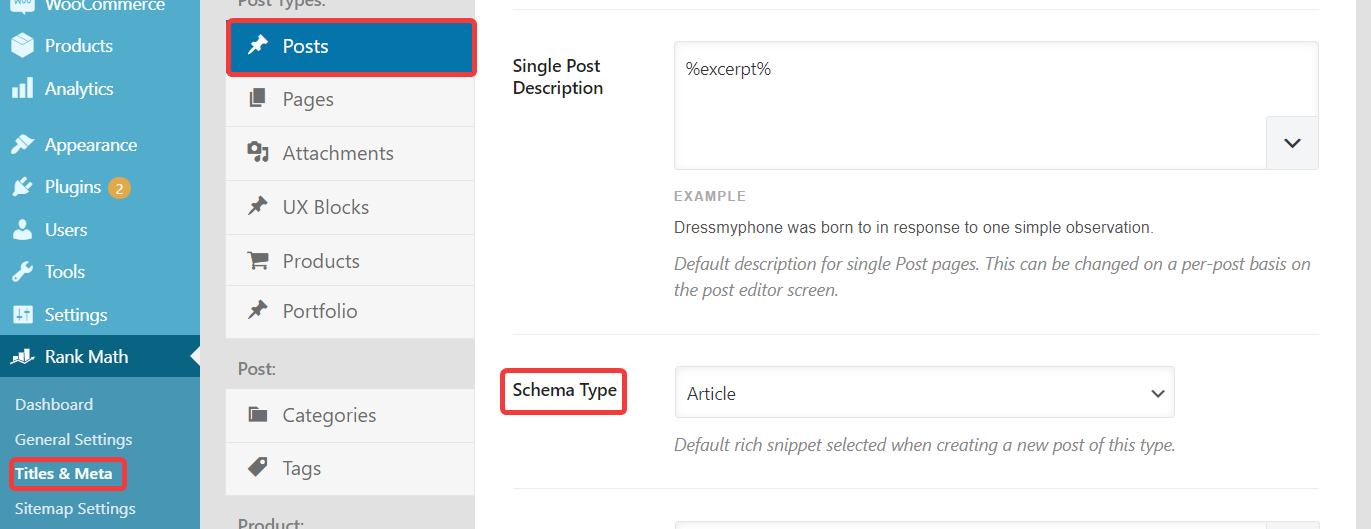
You should repeat the process for pages, products, and any other custom post types that you have on your website. You should also read our dedicated guide on configuring Rich Snippets in Rank Math.
How To Use Rank Math Analyzer
Search Console

Google Search Console (formerly Google Webmaster Tools) is a set of tools offered by Google to website owners. Once they verify their website ownership, Google gives them access to a lot of data about their website, like the keywords it ranks for, indexing status, performance, security issues, and many more.
Rank Math offers advanced integration with Google Search Console, using which you can see a lot of your website’s data inside your WordPress admin. This saves you a lot of time and makes actionable data accessible to you at your fingertips.
In this test, Rank Math checks if you’ve connected your Google Search Console with Rank Math or not. If you haven’t, you will see a warning.
We highly recommend that you connect your Search Console with Rank Math as it gives you actionable data about your website directly from Google right inside your WordPress admin area. It will save you a lot of time in digging out information as well as help you grow your website.
To connect Rank Math with Search Console, follow the instructions in the article about Search Console in Rank Math
Sitemaps
Sitemaps are like indexes for your website, and they help search engines discover content on your website more efficiently. This option checks your website’s sitemap and warns you if a sitemap is not found.
If you fail this test, then you need to check 2 things. First, if you actually have a sitemap for your website. If you’re using Rank Math, that is simple. Head over to Rank Math > Dashboard. On the Modules section, scroll down to see if the Sitemap module is enabled.
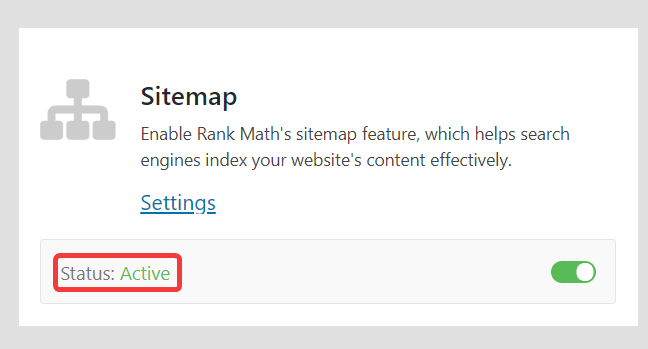
If you’re using another plugin for sitemaps, this can remain disabled. But, you’ll need to check if the other plugin is working as expected.
Second, if you’re using Rank Math, you need to make sure that your sitemaps are configured correctly. Head over to Rank Math > Sitemap Settings and verify if you’ve configured the settings correctly. You can refer to our article about configuring Sitemaps in Rank Math as a reference.
Performance
If you can recall the days of dial-up Internet, the performance of websites was never a big issue. The entire Internet was slow, and nobody had any big expectations. Of course, those days are long behind us.
Today, we expect sites to load quickly.
Better performance means happier users. People do notice it when sites load slowly – many of them will leave a site if it takes more than a couple of seconds to load. That’s a great way to lose visitors!
Improving your site’s loading time will improve your visitor retention, and that should improve your revenue. But that’s not the only reason for improving performance.
Why does Rank Math measure server performance? How is it related to SEO?
Site performance has become a significant ranking factor in the last couple of years. Google doesn’t want to send users to a site that gives a “bad experience” – it makes them look bad by reflection. Put simply, it’s harder to get a top ranking for your keywords if your site loads slowly.
There are lots of things you can do to improve your site’s loading time – Rank Math highlights the simplest fixes that produce the biggest result with the least effort.
Image Headers Expire

Most modern web browsers use caching to speed up the browsing experience of its users and save bandwidth. When using caching, one of the problems is that how would the browser know if the content is updated? The answer is expire headers. With each object, your server can attach an expire header, indicating that that element will not change for a specified amount of time.
Images are cached the same way too, and this option verifies if your images are using the Image Expires Header to improve the user experience. If Rank Math finds expires headers on your image headers; you will pass this test.
If you fail this test, you will have to add expire headers to your image assets yourself. Don’t worry; it is not too complicated. Here is a helpful guide that will teach you how to do it, and it also covers multiple approaches.
Minify CSS

When optimizing for the web, every byte counts. You might think that compressing something to save a few kilobytes is not a huge deal, but that would be incorrect. A single kilobyte of data saved will affect your website for all your visitors, for all of your website’s existence. It won’t be surprising that a few kilobytes saved by minimizing CSS would save hundreds or even thousands of megabytes over time.
In this test, Rank Math tests if your CSS files are minified. If they are, you pass the test. If you fail the test, you have multiple options to explore. You can either use a caching plugin like W3 Total Cache and configure minification of your CSS there or use an online tool like CSS Minifier to minify your CSS files. We’ve already covered the basics of minification with the W3 Total cache plugin in this blog post.
Please note that minify is not a set it and forget it process, and it has the potential to break your website. Therefore, we recommend that you first test out these changes on a testing/staging environment and then push them to your live website.
Minify JavaScript

Almost every website on the web uses JavaScript and minifying it is going to save you a lot of bandwidth while helping with website speed as well. Thus minifying JavaScript is also important. In this test, Rank Math tests if JavaScript files on your website are minified or not. If they are, the test is passed.
If you fail, you have a few options to consider. You can use a caching plugin like W3 Total Cache, which supports JavaScript minification and configure it there. Or, you could minify the files yourself by using an online tool like Javascript Minifier.
You should know that minifying JavaScript can have unintended consequences, including breaking a part of your website. In fact, minifying JavaScript is usually more troublesome than minifying HTML or CSS. Therefore, we recommend that you thoroughly test your changes in a staging environment before pushing changes to your live website.
Page Objects

A single web page that you browse is made up of multiple elements. You have the actual HTML, JavaScript, CSS, images, and then external resources. The problem is that each object on the page has to be separately requested by the server, and those requests take valuable loading time. If you could combine some of the resources together, that will reduce the number of requests, which will cut down on load times.
There is no established baseline on what the number of requests should be, but the lower, the better. In this test, Rank Math looks at the number of requests are made, and you pass if the number of requests is less than 20.
Page Size
The smaller the size of your page, the faster it will load. And, faster load times equals happy visitors. In this test, Rank Math calculates the total size of HTML of the page. If the size is less than 50 Kb, you pass the test.
To reduce the page size, and to speed up WordPress in general, follow this WordPress Speed Optimization guide.
Response Time
One of the key factors in the overall speed of your website is how fast does your server respond to requests. The faster the response, the better the loading times of your website. In this test, Rank Math tests the response time of your server. If the response is under 0.2 seconds, you pass the test.
Response time is affected by many factors, but unfortunately, the biggest factor is the host itself. If your page response is terrible, you are better off changing your host entirely. Here are several hosting recommendations for you to check out in case you do decide to change providers. If that’s not an option, we would recommend that you use a content delivery network, or CDN to speed up your website. a CDN will copy your website
Security
A key part of operating your website is keeping it secure from hackers and other malicious users. In this section, Rank Math checks your website for basic security issues and notifies you of any problems it can find. Here are the tests that it performs.
Visible Plugins
Hackers’ primary tool for hacking is information. The more information they can gather about someone or something, the more chances are that they’ll find a vulnerability in it to exploit. In this test, Rank Math tests which of your plugins are publicly visible, and notifies you if any of them are.
The reason why exposed plugins names create a security risk is quite simple. WordPress has millions of plugins, that means at any point in time, a few dozen plugins have security issues. The WordFence Blog does a fantastic job of reporting security issues in popular plugins. Now think about this.
A security issue has been discovered in a plugin. What will a hacker to in this case? He or she will try to find all the websites that have the plugin installed and try to hack them immediately. If the list of plugins installed on your website is public, then your website becomes an easy target. So, it is important that you secure your website and your web server.
Theme Visibility
Similar to plugins, themes can also have security issues. For the same reasons, you should try to hide the theme’s name from being publicly accessible. In this test, Rank Math tries to identify if your theme name can be discovered by theme detectors or other tools, and notifies you if it is.
Unfortunately, hiding the theme name is not a toggle you can switch on or off — you’d have to perform some steps to do so. Here is a good resource on how to hide your theme’s name which covers multiple approaches.
Directory Listing
A website is just a collection of files and folders on a web server, similar to what you’d see on your computer. A web server can actually display these files and directories, but for security reasons, the option needs to be disabled.
In this test, Rank Math checks if directory listing on your website is enabled, and warns you if it is.
If you fail this test, then the easiest way for you to disable directory listing is by contacting your hosting provider. If you’d like to disable the access yourself, then here is a helpful guide on how to do it for Apache Servers.
Google Safe Browsing
Google’s first priority is the user experience. That includes keeping users away from malicious websites. If you’ve ever visited a website and are greeted with a giant red warning screen, then you know what we’re talking about.
Malicious websites aren’t the only websites flagged by Google. Websites that get hacked are also flagged, as they can be used to harm end-users, even without the owners knowing.
In this test, Rank Math tries to find out if your website has been flagged by Google as malicious, dangerous, hacked, or any other red flag. If your website isn’t flagged, you’ll pass this test.
If you fail this test, then you’ll have to work to get Google to trust your website again. Start by going to your Google Search Console Account and seeing any notifications from Google. If you find them there, act on them, and fix everything going wrong with your website. If your website has been hacked, then you should consult a professional immediately. This guide on cleaning hacked WordPress websites is also quite useful to short-term damage control.
Secure Connection
Using a secure connection (https) is becoming important day by day as consumers are becoming more aware of the security of their data. On top of that, Google is also preferring secure sites and plans to give them the edge in the search results. For these reasons, you should switch to https, if you haven’t already.
In this test, Rank Math tests if your website is using a secure (HTTPS) connection. If it is, you pass the test.
If you fail this test, then you’re still using unsecured connections, which is a red flag to Google and to your users. We recommend that you switch to HTTPS quickly. Here is a helpful guide that outlines the process of doing so for WordPress websites without any costs.
Social SEO
Social media is an important part of the web, and billions of people use it and share content on it every single day. Since Google’s mission is to collect and organize the world’s information, social media data an important part of that information.
The other aspect of social media is that it is an easy way for a corporation, a brand, or even a small business to keep in touch with their potential customers. If you created your website for your business, then you must have created social media handles for it as well, right?
In the Social SEO section, Rank Math checks if you’ve connected your social media accounts with your website, and warns you if they are not.
Why is it important to connect your social handles with your website?
There are many benefits of connecting your social handles with your website. First, Rank Math automatically adds social handles to your contact information, wherever you post them. Second, it also adds your social media information to the correct meta-data, which helps search engines recognize which social media handles are your official handles. Although there are many social media supported in Rank Math, the SEO Analysis tool only checks for the following ones:
Facebook Connected
This option checks if there is a Facebook Page connected to your website and warns you if it isn’t.
Instagram Connected
This option checks if there is an Instagram Page connected to your website and warns you if it isn’t.
LinkedIn Connected
This option checks if there is a LinkedIn Profile connected to your website and warns you if it isn’t.
Twitter Connected
This option checks if there is a Twitter account connected to your website and warns you if it isn’t.
YouTube Connected
This option checks if there is a YouTube Page connected to your website and warns you if it isn’t.
Final Words
We hope that you see how valuable and powerful Rank Math’s SEO Analyzer is for your website. Without spending a dime on SEO tools, you can get a lot of valuable insights about your website, which will help you improve or fix your SEO efforts.
We’ve tried to explain all the tests, what they do, and what to if you actually fail one alongside the tests’ description. But, if you still have issues, or if you don’t understand the importance of a test, then support is just a few clicks away. Open on a support ticket on Rank Math’s Forum, and an expert will be available to assist you.
Also, make sure to run the SEO Analyzer occasionally, as changes you’ve made to your website might interfere with your SEO optimizations. We also add new tests to the analyzer frequently, so visiting the analyzer is a great way to discover new tests as well.









14 Comments
how long for mirtazapine to work
ReplyDeleteI don't understand your question, please come again
ReplyDeleteIt's appropriate time to make some plans for the future and it's time to be happy.
ReplyDeleteI have read this post and if I could I desire to suggest you some interesting things or
suggestions. Maybe you could write next articles
referring to this article. I wish to read more things about it!
0mniartist asmr
Appreciating the hard work you put into your blog and in depth information you offer.
ReplyDeleteIt's nice to come across a blog every once in a while that isn't the same
outdated rehashed information. Excellent read!
I've saved your site and I'm including your RSS feeds to my Google account.
0mniartist asmr
Today, while I was at work, my sister stole my iPad and tested
ReplyDeleteto see if it can survive a 40 foot drop, just so she can be a youtube sensation. My iPad
is now broken and she has 83 views. I know this is completely off topic but I had to share it with someone!
0mniartist asmr
whoah this blog is magnificent i really like studying your articles.
ReplyDeleteKeep up the good work! You already know, many people are looking round
for this info, you could aid them greatly.
I am actually glad to glance at this website posts which consists of plenty of valuable information, thanks for providing these data.
ReplyDeleteThat is a good tip particularly to those new to
ReplyDeletethe blogosphere. Short but very precise info… Appreciate your sharing this one.
A must read article!
I believe that is among the such a lot vital info for me.
ReplyDeleteAnd i am happy reading your article. However wanna statement on few basic things,
The website taste is great, the articles is in point of fact excellent :
D. Just right job, cheers
I always emailed this website post page to all my associates, since if like to read it then my friends will too.
ReplyDeleteIf you wish for to obtain a good deal from this
ReplyDeletepost then you have to apply such strategies to your won webpage.
I feel that is one of the most important information for me.
ReplyDeleteAnd i am glad reading your article. But should statement on few normal things, The web site taste is ideal, the articles
is truly nice : D. Good process, cheers
It is perfect time to make some plans for the future and it is time to be happy.
ReplyDeleteI've read this post and if I could I want to suggest you some interesting things or tips.
Perhaps you could write next articles referring to
this article. I want to read even more things about it!
scoliosis
ReplyDeleteHello, just wanted to say, I liked this post. It was funny.
Keep on posting! scoliosis